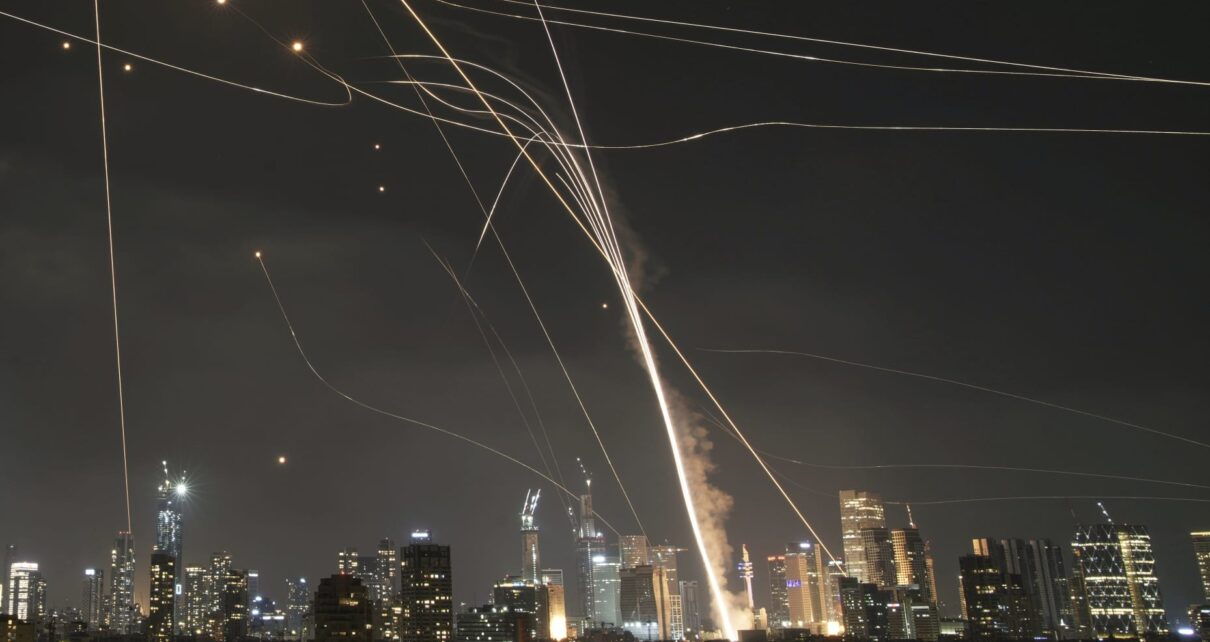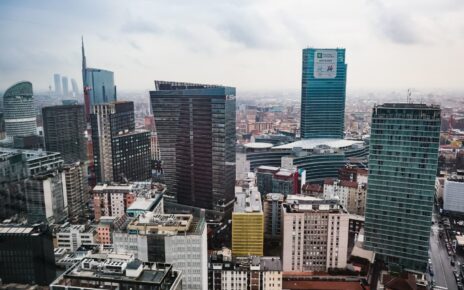A projectile struck buildings as the Iron Dome defense system actively intercepted missiles over Tel Aviv, underscoring the enduring role of this mobile, all-weather shield in Israel’s security landscape. The Iron Dome, known in Hebrew as Kippat Barzel, stands as one of the most referenced and widely deployed components of Israel’s defense network, designed to protect civilians from short-range aerial threats by launching guided missiles to intercept incoming projectiles. Operational for over a decade, its continued evolution and deployment reflect ongoing strategic priorities, regional dynamics, and the evolving nature of rocket and missile warfare. The system’s developers and supporters emphasize its multi-layered approach, rapid response, and the way it complements other air defense capabilities to reduce casualties and damage during hostilities. Over the years, the system has undergone multiple upgrades, and its developers and government partners consistently point to its effectiveness in diminishing the impact of rocket attacks on communities and critical infrastructure. The Iron Dome’s creation and deployment have been closely tied to the broader security relationship between Israel and its international partners, especially the United States, which has provided support and funding across successive administrations. While the system represents a significant technological achievement, analysts and policymakers alike have noted its limitations and the challenges it faces in fast-moving, large-scale attack scenarios. The ongoing deployment, procurement, and development of the Iron Dome are part of a broader conversation about ensuring resilience for civilian populations in the face of evolving threats, and about how best to balance investment across multiple defense layers to protect long-term national security interests.
What the Iron Dome Is and How It Evolved
The Iron Dome is a mobile, responsive defense system designed to counter short-range rockets, artillery, and other similar threats through a combination of radar detection, command-and-control processing, and interceptor missiles. Its core mission is to detect incoming threats, determine which projectiles pose a real danger to populated areas or critical sites, and respond with a precise intercept that minimizes collateral damage and civilian harm. The system’s architecture integrates several essential elements: advanced radar for real-time tracking, a command-and-control center to assess trajectory and risk, and a fleet of Tamir interceptors that are directed toward the threat once a threat is confirmed. The design emphasizes rapid decision-making and modular deployment, enabling the system to be moved or expanded as needed to respond to changing security circumstances. The Iron Dome’s development is notable for its collaborative origins, combining Israeli defense expertise with international support, and for its emphasis on a modular, scalable approach that can be deployed across the country to defend multiple urban and strategic areas. Since its introduction into operational use, the system has been upgraded with new sensors, improved interceptors, and refined algorithms for target discrimination and engagement, all aimed at improving interception success rates and reducing false alarms. The ongoing upgrades reflect a commitment to maintaining relevance as threats evolve and as adversaries explore more sophisticated or diversified means of attack. The defense ministry has underscored that these upgrades are not one-off enhancements but part of a continuous process of modernization designed to adapt to new threat landscapes while preserving the essential defensive doctrine behind Iron Dome. The system’s development was rooted in addressing the real-world need to protect civilian populations and critical infrastructure from short-range rocket arsenals, a need that has persisted through multiple rounds of conflicts and flare-ups. The broader defense strategy that supports the Iron Dome views it as a mobile, all-weather shield that can operate under various weather conditions and geographic scenarios, ensuring that protection remains available across different times and places. This expansion of capability has included improving interoperability, logistics support, maintenance cycles, and the ability to operate in conjunction with other air defense layers, thereby enhancing overall resilience in the face of diversified aerial threats. In practice, the Iron Dome’s evolution has mirrored Israel’s broader approach to crisis management and civil defense, where rapid response, targeted engagement, and minimizing disruption to daily life are central objectives.
The defense ministry has repeatedly stated that the Iron Dome system has been upgraded on several occasions and that those upgrades have contributed to preventing countless rockets from hitting Israeli communities. This ongoing modernization is part of a broader strategy to maintain a robust deterrent and to reduce the burden of threat on civilians. The system’s origins lie in collaboration between the state-owned Rafael Advanced Defense Systems and U.S. support, reflecting a cross-border partnership in defense technology development and procurement. Washington’s backing has spanned funding, co-production arrangements, and maintenance support, reinforcing the system’s reach and sustainability over time. The Iron Dome is not a single component but rather a networked constellation of capabilities that work together to create an integrated defense architecture. Its key elements include the radar network, the command-and-control nexus, and the interceptor launchers that deploy Tamir missiles to intercept incoming threats. The system’s strength lies in this integrated approach: detection and discrimination are carried out by sophisticated radar and software, decision-makers issue engagement orders, and highly capable interceptors perform targeted interceptions to protect populated areas and critical infrastructure. This layered design has been central to the system’s ability to respond quickly to multiple threats and to do so with a high degree of precision. The product of Israel’s defense industrial base, the Iron Dome also embodies a broader strategic principle: a mobile, flexible, and scalable defense asset that can be deployed across varied terrains and cities, adapting to the density of population and the strategic value of potential targets. Its continued deployment across the country reflects a long-standing policy goal of maintaining deterrence while preserving civilian safety and maintaining continuity of daily life even during periods of elevated threat. The technology behind the Iron Dome has thus become a symbol ofIsrael’s defense posture—an emblem of how advanced, responsive defense measures can shape the strategic calculus in a volatile regional environment.
How the Iron Dome works is a blend of radar sensing, computational assessment, and rapid interception. In practice, the system uses radar to track the flight of incoming rockets and to determine whether their trajectory threatens protected areas such as population centers, critical facilities, or strategic infrastructure. When the system identifies a potentially dangerous flight path, a command-and-control center issues an engagement order. This order prompts the launch of a Tamir interceptor to intercept the incoming rocket and prevent it from striking its intended target. The operational philosophy includes a safeguard: the system is not configured to fire outside of protected zones. Rockets that do not pose a risk to people or critical assets are typically not engaged and are allowed to land beyond the defended area. This selective engagement approach is intended to optimize resource use and minimize unnecessary interceptions, while maintaining a high level of protection for vulnerable areas. The destructive intervention, such as an interceptor flight, is a carefully controlled act designed to maximize effectiveness and minimize unintended consequences, including collateral damage. The result is a defense posture that emphasizes precision, risk assessment, and the efficient use of interceptor resources. Over time, the system has demonstrated impressive responsiveness, with thousands of interceptions attributed to the network in various conflict scenarios, helping to reduce the civilian toll and damage in many episodes of hostilities. The design philosophy behind this precision-driven approach continues to inform future upgrades, with attention to improving discrimination between lethal threats and non-threatening objects, reducing potential intervention when not necessary, and strengthening the overall resilience of the defensive network under stress conditions.
A 2023 report describing the Iron Dome noted its capacity as a mobile anti-rocket, anti-mortar, and anti-artillery system capable of intercepting launches from 2.5 to 43 miles away. The system is described as a flexible, mobile platform able to defend a sizeable area against a range of short-range threats. In terms of scale, it is estimated that at least 10 batteries are deployed nationwide, each designed to defend a 60-square-mile populated area, a design intended to cover densely populated urban zones and critical economic hubs. Within each battery are three to four launchers, and each launcher can hold up to 20 Tamir interceptors, giving the system the ability to engage multiple threats in a single engagement window. The logistics behind maintaining several batteries involve continuous refreshment of interceptors, maintenance of radar and command networks, and the training and readiness of teams operating the system. The Interceptors, the Tamir missiles, are the kinetic countermeasures that execute the engagement plan, and they require precise guidance from the system’s sensors and computing resources to reach their target with high probability. The scale and configuration of batteries and interceptors reflect a balance between coverage, cost, and the ability to defend against multiple, simultaneous attacks—an important consideration given the potential for saturation attacks that aim to overwhelm defenses with large volumes of missiles. The architecture is intended to optimize the protective envelope around key population centers and to provide a credible deterrent by presenting a capable and responsive defensive system. The design also implies an emphasis on redundancy and resilience: the distribution of batteries across a country ensures that a single point of failure does not collapse national defense. The strategic calculus behind such deployment takes into account not only the physical capabilities but also the operational readiness, logistics, and the political and economic implications of maintaining a sophisticated, multi-battery defense network over time.
The Center for Strategic and International Studies, a U.S. think tank, has estimated that a single Iron Dome battery costs more than $100 million to produce. This figure speaks to the substantial capital outlay involved in acquiring and sustaining the system, including the cost of interceptors, launchers, radar arrays, command centers, and the associated logistics for maintenance and operation. The high cost per battery is balanced by the potential value of preventing casualties, protecting critical infrastructure, and reducing the economic and human toll of attacks. The financial footprint of the Iron Dome is influenced by ongoing production, upgrades, and the need for continuous stockpiles of interceptors, which are consumables in the sense that they are expended in engagements. The broader cost structure includes not just the hardware but also the software updates, training, and system integration with other defense layers, all of which contribute to the overall resource planning required to maintain a credible, ready-to-fire system. In the broader defense budgeting context, the price per battery is weighed against anticipated threat levels, regional stability considerations, and allied support arrangements. The economic dimension of Iron Dome extends beyond a single unit, encompassing the cumulative impact of multiple batteries deployed over time and the long-term maintenance and upgrade cycles that ensure the system remains effective against evolving threats. The operational cost is thus a factor in strategic calculations about deterrence, readiness, and alliance commitments, reflecting the critical balance between protection and expenditure in national security planning.
Since 2011, the United States has provided billions of dollars to Israel for Iron Dome batteries, interceptors, co-production costs, and general maintenance since the system became operational. The financial support has been a cornerstone of the closer security relationship between the two nations, reflecting shared strategic interests and the desire to sustain a defense capability that can mitigate threats to civilian populations. Much of this funding has proceeded through fiscal appropriations approved by Congress, where bipartisan majorities have consistently backed financial support for Israel’s Iron Dome program. The funding has enabled not only the procurement of batteries and interceptors but also the development of co-production arrangements, maintenance agreements, and ongoing upgrades to the system’s capabilities. The continued congressional support signals a long-standing recognition in Washington of the value of the Iron Dome as a strategic asset within the broader regional security architecture. The financial relationship thus underscores the importance of allied defense collaborations in maintaining credible deterrence and rapid response options for civilian protection in times of elevated threat. The scale and continuity of U.S. support have also fostered broader cooperation in defense technology development, interoperability, and logistical readiness, helping to ensure that Iron Dome remains an operationally robust system capable of responding to changing threat conditions.
The Iron Dome has its weaknesses, however, and analysts warn that the defense system can face challenges when confronted with heavy rocket fire. In particular, the risk of saturation attacks, where an adversary fires multiple missiles from different directions simultaneously to overwhelm the defense network, has been a concern among analysts and policymakers. A saturation attack can strain radar tracking, command-and-control processing, and interceptor availability, potentially reducing the probability of intercept for some incoming threats. The concerns about saturation reflect a broader understanding of the dynamic battlefield environment, where the volume, speed, and variety of threats can test the system’s capabilities in ways that single-target engagements cannot. The Center for European Policy Analysis, a U.S. think tank, noted in 2021 that the Iron Dome could be vulnerable to such an attack strategy, highlighting an area of potential weakness that defense planners must mitigate through operational tactics, networked defense layers, and ongoing upgrades. The consensus among analysts is that while the Iron Dome offers a highly effective layer of protection against a broad spectrum of short-range threats, its effectiveness is not absolute and depends on the density and profile of the incoming missiles, the coordination with other defense layers, and the pace at which the system can process data and launch interceptors. As with any advanced defensive technology, continuous assessment, improvements in sensor fusion, and enhanced interoperability with additional protective layers are seen as key elements to maintaining resilience under high-intensity conditions. The ongoing dialogue around weaknesses and vulnerabilities contributes to a broader strategic conversation about how to structure defense in a way that preserves civilian safety even when faced with multi-directional, high-volume attacks.
In the meantime, the ongoing reality of rocket and missile threats places a premium on multi-layer defense strategies that combine Iron Dome with other capabilities designed to handle longer-range missiles, artillery shells, and other aerial threats. The broader security environment in which Israel operates requires a robust mix of defense systems that can work in concert to defend the country’s airspace and maintain civilian protection. The Iron Dome plays a critical role within this layered architecture by providing rapid interception for short-range threats in populated areas, while other defense layers complement its capabilities to address longer-range or more sophisticated attack profiles. The interplay between the different defense layers—each with its own strengths, limitations, and operational requirements—offers a more resilient defense posture than reliance on a single system alone. As threats evolve and new forms of military technology emerge, defense planners continually reassess how to optimize the mix of tools available, ensuring that protection for civilians remains a central objective. This ongoing assessment includes evaluating engagement doctrines, refining sensor technologies, and optimizing the allocation of interceptors to maximize protective coverage across the country. In this way, the Iron Dome remains an integral component of a broader strategy aimed at mitigating risk for Israeli communities under fire while enabling normal life to continue as much as possible even during periods of heightened tension.
The system’s weaknesses should be understood in the context of its strengths and the demands of its mission. Analysts emphasize that the Iron Dome represents a substantial defensive capability capable of neutralizing a large fraction of short-range threats, particularly when integrated into a comprehensive air defense framework. Its performance is often described as a meaningful barrier that reduces casualties and property damage, even if it cannot guarantee interception of every incoming projectile in every scenario. The ongoing evaluation of weaknesses, combined with improvements and close cooperation with international partners, helps shape a defense posture that remains adaptive to the evolving threat landscape. The discussion around the Iron Dome’s limitations is not a critique of its overall value but rather a realistic accounting of what any complex defense system can and cannot achieve when confronted with a broad spectrum of attack vectors. The ultimate takeaway is that the Iron Dome provides a high level of protection for civilians and critical infrastructure, while acknowledging that protection is not absolute and must be supported by other layers of defense and protective measures, including civil defense protocols and emergency response capabilities. The evolving conversation about both capabilities and limits informs policy decisions, funding allocations, and strategic planning as Israel continues to navigate a volatile security environment.
The ongoing dialogue about the Iron Dome includes its role in deterrence, crisis management, and civil protection. The system’s presence is widely seen as a central element of Israel’s approach to ensuring public safety during periods of heightened hostilities, with its ability to quickly detect, assess, and respond to threats contributing to a broader sense of security for population centers and essential services. The coordination between the Iron Dome and other defense assets—whether in the air, on land, or at sea—illustrates a comprehensive approach to air defense that seeks to anticipate, deter, and respond to threats in a manner that preserves civilian life and stabilizes the security situation. In addition to its immediate protective effects, the Iron Dome also serves as a symbol of defense capability and technological innovation, reflecting how advanced systems can shape strategic thinking and international partnerships. The system’s deployment and continued development remain a practical testament to how nations leverage technology to manage risk, reduce casualties, and maintain a functional civil environment even amid ongoing regional tensions and episodes of escalation. As new threats and attack patterns emerge, policymakers and defense professionals will continue to scrutinize the Iron Dome’s performance, explore potential upgrades, and consider how best to allocate resources within a multlayered defensive approach that prioritizes civilian safety and national security objectives.
The safety and security implications of the Iron Dome are broad and multifaceted. By actively engaging threats and preventing many attacks from reaching populated areas, the system contributes to a positive impact on daily life during times of conflict, preserving normal activities and reducing the potential for mass casualties. At the same time, the existence of a sophisticated defense system can influence the calculus of adversaries, potentially deterring certain actions or prompting evasion strategies that seek to circumvent interceptors. This dynamic underscores the complexity of modern defense planning, where technological capabilities intersect with political, strategic, and psychological factors. The net effect of the Iron Dome, in many analyses, is a combination of tangible protection and wider strategic signaling about a nation’s willingness and ability to defend its people. As technology continues to advance, the system’s operators will face ongoing decisions about resource allocation, upgrade priorities, and the integration of new sensor and interceptor capabilities to maintain effectiveness in changing combat environments.
The broader public policy and defense strategy context surrounding Iron Dome also includes considerations about cost-effectiveness, long-term sustainment, and alliance commitments. These factors influence decisions about how many batteries to deploy, how to allocate interceptors, and how to balance investments across multiple dimensions of national security. The defense community will continue to weigh the benefits of rapid response against the need for thorough protection across all threatened zones, ensuring that the system’s deployment aligns with strategic priorities and budgetary realities. The ongoing conversation about the Iron Dome remains essential to understanding how a state can pragmatically manage risk, protect civilians, and sustain a credible deterrent in a volatile regional landscape. By examining both the system’s achievements and its limitations, policymakers can better ensure that Israel maintains a robust, adaptable, and cost-conscious defense posture capable of responding to the evolving threats of the present and the future.
Conclusion
The Iron Dome stands as a pivotal element of Israel’s defense architecture, combining advanced sensing, rapid decision-making, and precise interception to protect civilian life and infrastructure from short-range threats. Its ongoing upgrades, extensive deployment, and sustained support—from international partners and domestic institutions alike—highlight the importance of continuous innovation in modern air defense. While not without weaknesses or limitations, the system’s overall contribution to civilian safety and strategic stability remains significant. The dialogue around its capabilities, costs, and strategic role reflects a broader understanding of how nations defend themselves in a complex, multi-faceted security environment. As threats continue to evolve, the Iron Dome’s continued relevance will hinge on ongoing improvements, effective integration with other defense layers, and a sustained commitment to safeguarding populations in the face of proximate aerial threats.



